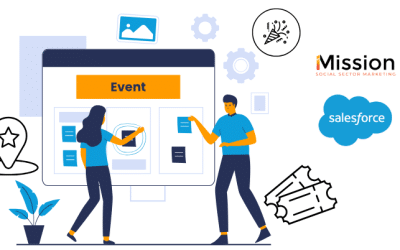Choosing the right email marketing platform for your organization is a big decision.
And that’s because email marketing works — it’s one of the most powerful digital channels in terms of ROI and the potential to drive donations. According to the M&R Benchmarks study, email accounted for 15% of all online revenue for nonprofits in 2021.
To help you get started with this decision, here’s a comparison of two popular email marketing platforms: Mailchimp and Salesforce’s Marketing Cloud.
Let’s take a look at four of the top factors that organizations need to consider: cost, features and capabilities, integrations, and user reviews.

How much does email marketing cost?
Cost is not surprisingly usually the first deciding factor that comes to mind, especially for nonprofit organizations.
Like many digital tools and platforms, both MailChimp and Marketing Cloud have a range of pricing plans, so you can scale up or down to find the right fit.
Mailchimp pricing starts as low as free (with many restrictions) and goes up to $299 per month for the premium plan. Most organizations would probably need at least the standard plan, which is $17 per month. MailChimp does offer a 15% nonprofit discount, and recommends signing up for a free account and contacting the billing department.
Marketing Cloud is undeniably a much more expensive platform, but with many premium features. The pricing models range from $400 per month to $3,750 per month for the full suite. All of the plans include responsive customer service support, interactive webinars and other learning tools.
How do the features and capabilities compare?
Both MailChimp and Marketing Cloud offer the tools necessary for you to build and send personalized emails, execute automations and drip campaigns, and track performance metrics.
With either platform, you have the ability to A/B test, use dynamic content, optimize for mobile, manage audience lists and adhere to CAN SPAM compliance.
But there are some differences in capabilities.
The higher tiers of Marketing Cloud plans include Mobile Studio, where you can send targeted SMS and MMS messages. There’s also Einstein Analytics, an advanced analytical tool with artificial intelligence.
Mailchimp offers great creative tools, like a subject line helper, and a drag-and-drop web page builder. Its overall branding is very user-friendly — even fun — making it easy to get started and find helpful tips along the way.
When it comes to building drip campaigns, or email journeys, both platforms include sophisticated capabilities that allow you to send personalized emails to your donors based on behavioral triggers (like abandoning a cart, or signing up for emails, etc.)
MailChimp’s Customer Journey Builder provides a bit more hand-holding, with a library of pre-built customizable journeys to help you get started with automation.
The best way to learn about Marketing Cloud’s Journey Builder is through Salesforce’s Trailhead courses and webinars. One exciting benefit to using Marketing Cloud for email journeys is that if you also purchase Social Studio and/or Ad Studio, their management tools for social media posting and advertising, you can integrate social content into your journeys along with emails and SMS. This creates a more holistic, omnichannel experience for your donors.
Email marketing integrations
It’s important to make sure you choose an email marketing platform that integrates with your CMS and other digital tools.
Marketing Cloud, unsurprisingly, integrates seamlessly with other Salesforce platforms. If your organization uses Salesforce as your CMS, you’d be able to build donor reports in Salesforce and import them into Marketing Cloud, keeping everything synced automatically.
There are also integration connectors you can buy to integrate Marketing Cloud with different ecommerce platforms, like Shopify.
Mailchimp integrates with over 300 tools and apps, all of which can be found in their integration directory. It also works with Zapier, which Marketing Cloud does not, and provides developer tools.
What user reviews say
To hear directly from other organizations and companies who have used these email platforms, you can check out their pages on Capterra, a free site that provides software reviews and ratings.
Marketing Cloud has an overall 4.1 rating, while Mailchimp comes in slightly higher with a 4.5 average. The biggest discrepancy is in ease of use, with Marketing Cloud at 3.6 and Mailchimp at 4.4.
Deciding which email platform is right for your organization
Both Marketing Cloud and Mailchimp are effective email marketing platforms that can help your organization reach more supporters and drive revenue.
Marketing Cloud is a bigger financial investment, but if your team is prepared to dive into learning how to use it to its full capacity, or if you have a digital agency partner to help, it could bring your digital efforts to new levels.
Mailchimp might be your preference if you don’t need or won’t be able to take advantage of all of Marketing Cloud’s features, or if you have a lower budget.
It really comes down to deciding which platform is the best match for your marketing needs.
We’re here to help you! iMission Institute partners with nonprofit organizations to help them unlock the potential in technology. We can help you make these decisions, create strategies and implement digital solutions.



